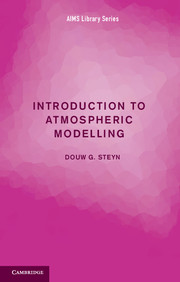1 - Atmospheric phenomena and their study
Published online by Cambridge University Press: 05 April 2015
Summary
Earth's atmosphere is a shallow fluid held by gravity to the surface of a spinning sphere whose surface is heated by electromagnetic radiation from the sun. Roughly two thirds of the sphere is covered by water, which continuously undergoes evaporation, condensation, freezing, thawing and sublimation. There is continuous turbulent transport of water vapour and heat between atmosphere and surface. At global scale, the atmosphere is in continuous motion, driven by a relative excess of heating in equatorial regions relative to higher latitudes. The net effect of this motion is a latitudinal redistribution of heat, either directly or by a net transport of moist air from the tropics to higher latitudes where it condenses and falls as precipitation.
Atmospheric large scale motion results in a cascade of energy to smaller scales, producing a complex palimpsest of motion of various types, and at a wide range of scales from global (tens of thousands of kilometres) to a microscale on the order of millimetres. In spatial terms, these motions include some that are quasi two-dimensional, some that are fully three-dimensional, some that are strongly wave-like, and some that are appropriately described as chaotic. Temporally, the motions have time scales of variability that range from astronomically forced variations over tens of thousands of years to turbulent fluctuations of a few seconds in duration, and more recently, decade scale temporal trends driven by human industrial activities. In addition to the purely dynamical phenomena I have just described, the atmosphere includes phenomena whose dynamics are powerfully influenced by thermodynamic processes (such as cloud and precipitation processes) and a wide range of fascinating atmospheric optical phenomena (such as rainbows and circumsolar haloes). This book will primarily concentrate on atmospheric dynamical phenomena, whose time and space scales are graphically shown in Figure 1.1. These phenomena are conventionally grouped into micro, meso and macro scales, and most analyses of atmospheric phenomena focus only on one of the ‘scales’. This narrowing of focus has become so sharp that most atmospheric scientists will label themselves according to the ‘scale’ they study.
- Type
- Chapter
- Information
- Introduction to Atmospheric Modelling , pp. 1 - 24Publisher: Cambridge University PressPrint publication year: 2015

